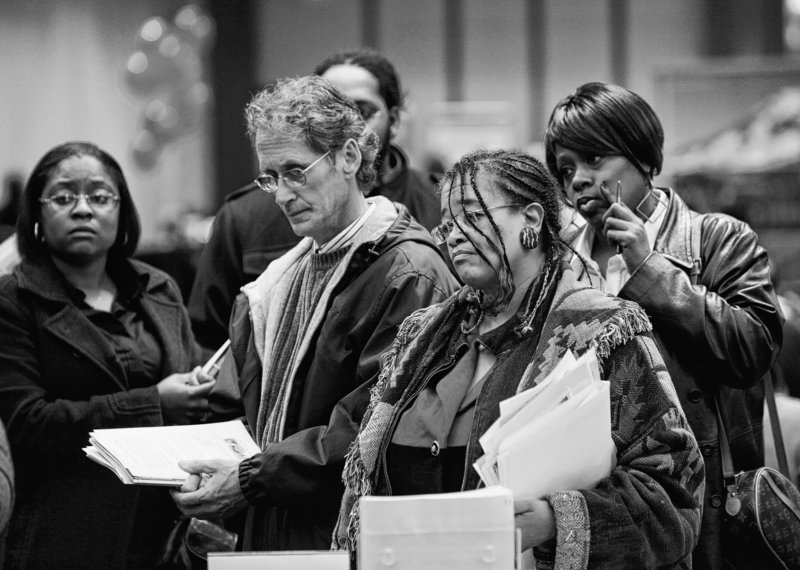WASHINGTON – The nation added only a trickle of jobs in November, far fewer than experts had expected and a reminder that the economy is still recovering only fitfully.
The job market was weak all around: Stores, factories, construction companies and financial firms all cut positions. The unemployment rate nudged closer to double digits again — 9.8 percent, after three straight months at 9.6 percent.
Employers added 39,000 jobs for the month, the Labor Department said Friday. They added 172,000 in October — enough to qualify as a hiring spurt in this anemic post-recession economy.
“Just when it was safe to believe the labor market was firming and job growth was coming back, we were reminded that this recovery is proceeding with fits and starts,” said Joel Naroff, president of Naroff Economic Advisors.
The report caught economists off guard. They had predicted 150,000 new jobs, based on a raft of recent positive reports that showed busier factories, rising auto sales and a healthy start to the holiday shopping season.
The stock market seemed to take the bad news in stride. The Dow Jones industrial average closed up about 20 points at 11,382, not far from its post-recession high.
The November jobs report may prove to be just a temporary setback because economic recoveries are often bumpy. But for now, hiring is so weak that the economy isn’t creating even enough jobs to keep up with the growth in the work force.
It takes about 125,000 new jobs a month to do that and keep the unemployment rate stable. Economists say it would take up to 300,000 new jobs a month to reduce the unemployment rate significantly.
“It will be a long haul back to normalcy,” said Ian Shepherdson, chief U.S. economist at High Frequency Economics.
The rate, now at a seven-month high, has exceeded 9 percent for 19 straight months, the longest stretch on record. It could pass 10 percent, as it did briefly in late 2009, again next year.
“Employers are still cautious about hiring and are testing waters before taking on full-time employees,” said Sung Won Sohn, economist at California State University, Channel Islands.
Vice President Joe Biden called the unemployment figures disappointing and pressed lawmakers to extend long-term unemployment benefits, which expired this week, before Congress adjourns for the year.
Programs that provide up to 99 weeks of extra aid to nearly 2 million unemployed people expired at the end of November because Congress failed to extend them. Some of them are starting to lose their benefits as the holidays arrive.
Congressional negotiators are considering extending tax cuts temporarily, for one to three years. The tax cuts, enacted in 2001 and 2003, are due to expire at year’s end. Democrats and the White House also want to extend unemployment benefits for one year as well as several tax credits included in the 2009 economic stimulus.
The jobs picture may actually be brighter than the report suggested because it was more difficult than usual for the government to come up with the November figure. That’s because the previous two Novembers were volatile, and the government uses previous years to make seasonal adjustments in the figures.
As disappointing as November’s report was, erratic job growth after a recession is hardly unusual. After the 2001 downturn officially ended, the economy lost jobs in 16 of the following 24 months.
Private companies, the backbone of the economy, created only 50,000 jobs for the month. That was down from 160,000 in October and the fewest since January. Private sector hiring has at least grown for 11 straight months.
Yet companies are still not prepared to hire in great numbers. They have the cash to do it — corporations had amassed $1.84 trillion of it as of June 30, a record — but are not yet satisfied that customer demand is really back.
There were 15.1 million people unemployed in November. Adding people who were working part-time but would prefer full-time jobs, plus those who have given up looking for work, about 27 million people are “underemployed,” 17 percent of the labor force.
The number of workers considered “discouraged” — not looking for jobs because they think none are available to them — reached 1.3 million in November. And the number unemployed for at least six months rose to 6.3 million.
Paychecks edged up by only a penny, to an average of $22.75 an hour, and average weekly hours worked held steady at 34.3.
Stores cut about 28,000 jobs, factories 13,000, financial companies 9,000 and construction companies 5,000. Government eliminated 11,000 jobs, mostly at the local level.
The health care sector added 19,000 jobs, mostly at hospitals. Temporary-help firms added 40,000, education about 6,000, and hospitality companies 11,000.
Copy the Story Link
Send questions/comments to the editors.



Success. Please wait for the page to reload. If the page does not reload within 5 seconds, please refresh the page.
Enter your email and password to access comments.
Hi, to comment on stories you must . This profile is in addition to your subscription and website login.
Already have a commenting profile? .
Invalid username/password.
Please check your email to confirm and complete your registration.
Only subscribers are eligible to post comments. Please subscribe or login first for digital access. Here’s why.
Use the form below to reset your password. When you've submitted your account email, we will send an email with a reset code.